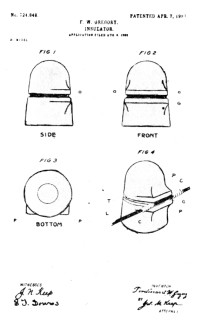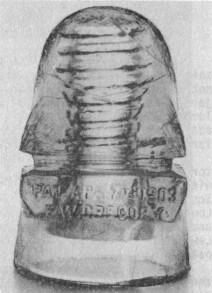Patent Pages
by Ray Klingensmith
Reprinted from "INSULATORS - Crown Jewels of the Wire", February 1978, page 18
This column, hopefully each month, will be dedicated to the
"Patents", that is, the insulators which were patented by their
inventors. I find many of these items very interesting, and in viewing the old
patent copies, so much can be learned about these unusual jewels. Many
insulators have been identified (manufacturer, age, use, etc.) through the use
of patent copies. So, each month I'll attempt to feature a different item. Once
again, if anyone has any info to add or has any differences in opinions, please
feel free to write me at 709 Rt. 322, E. Orwell, OH 44034. Let's get started on
this month's item.
This month the "Patent Pages" item is the GREGORY.
This item has been assigned CD #159 by N. R. Woodward. It is a very unusual and
quite scarce item. In most cases the wire groove and corners are damaged. I have
heard of only one mint specimen. It's hard to estimate exactly how many of these
exist in collections, but there aren't many. In my opinion, this has been one of
the most underrated (rarity and value wise) of all insulators. All Gregorys, to
my knowledge, were found in western Nevada or eastern California. This was in
the snowy mountainous areas where wet snow gathered on the telegraph wires. The
added strength (in the wire groove) of this design explains its use there. (I
thought I should also note it's reported one of these was used on a barn in
Ohio. I have not definitely confirmed this as yet, but it sure is interesting.)
On April 7th, 1903, Ferdinand W. Gregory, a resident of New York, New York, was
granted a patent for an improvement in insulators. It was patent number
724,848. I might also add it was filed August 9, 1902. Gregory's claim reads . .
. "said insulator having upon its exterior a vertical face spanning the
width of said insulator and longitudinally across said face a groove of
sufficient depth to house a line-wire and form a substantial rest for said line
wire when therein confined by a tie-wire, a tie-wire groove encircling the
cylindrical part of the knob and forming a continuation of the straight
groove."
What he was saying, was his improvement consisted of an insulator with a groove deep enough to completely receive the line-wire and hold it
in place, this being made possible due to the insulator's peculiar design.
I
find it interesting that the patent drawings, (fig 1-4) differ from the actual
insulator found. The one in the patent is a "beehive" shape insulator
with only one side squared at the wire groove. The actual insulator (fig 5) is a
"beehive" shaped insulator with four squared sides at the wire groove.
Gregory, in his patent application states his insulator may be formed with the
"verticle face" on one or more sides. There are three possible
explanations as to the actual insulator having four "squared sides"
instead of one as in the patent drawing.
- Gregory decided before he had them
manufactured, it would be a better design with four sides.
- The manufacturer explained to Gregory the benefits of a design that way, and then made them
that way.
- They were possibly made as in the patent drawing, and in use
were found unsatisfactory, then redesigned.
The third possibility is unlikely,
but very possible. Wouldn't it be interesting if someone found a Gregory with
only one squared side?

Patent drawing of the Gregory showing the one squared side, rather than the
four squared sides actually found on the specimens known to us. |

Front view of a Gregory. The em bossing reads: PAT. APR. 7TH 1903 F. W.
GREGORY. Aqua color very sim ilar to Hemingrays of the same per iod indicates
one possible mfr. |
To date, the manufacturer is unknown. It could have been anyone, even one
of the larger companies such as Brookfield or Hemingray. I don't have a 1912
Brookfield catalog reprint to know if this item appears in it. Even if it
doesn't, it's possible Brookfield could have made it. It's bad practice to guess
"who made what", but I think the glass texture and uniform aqua color
appears a lot like that of many Hemingrays of the same period. Gregory was from
New York. With Brookfield "just around the corner", Brookfield could very
easily have made these. So, I would guess it was either a Hemingray or
Brookfield item. But once again this is only a guess, as we have no facts to
determine their origin.
Something else I may add in reference to this and all
other patents: The insulator must resemble only that part which is covered in
the patent. In other words, the actual insulator may be of a totally different
style, so long as that part covered in the patent is the same.
That's all for
this month. Anyone have anything to add? If so, let me know.
In April the patent
covered will be a super classy piece, the elusive EMMINGER.
|
